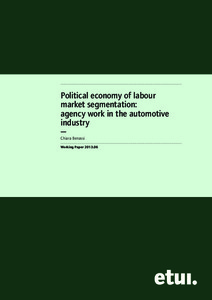Political economy of labour market segmentation: agency work in the automotive industry
" This paper investigates cross-company variation in the core-periphery configuration of the workforce. The empirical focus is on four automotive plants in Germany, which differ in terms of their organisation of agency work. The comparison reveals that there is no automatic relationship between...
| Main Author: | |
|---|---|
| Institution: | ETUI-European Trade Union Institute |
| Format: | TEXT |
| Language: | English |
| Published: |
Brussels
2013
ETUI |
| Subjects: | |
| Online Access: | https://www.labourline.org/KENTIKA-19123092124919412749-Political-economy-of-labour-ma.htm |
| Summary: | " This paper investigates cross-company variation in the core-periphery configuration of the workforce. The empirical focus is on four automotive plants in Germany, which differ in terms of their organisation of agency work. The comparison reveals that there is no automatic relationship between skills, products and company workforce structure. As traditional employer-driven explanations such as production requirements and skills fail to make sense of the variations encountered, the main argument of the paper is based on the power-resource approach.
More specifically, the strategy devised by works councils in relation to managerial imperatives has a major role in shaping employment and the core-periphery configuration in the subsidiaries. The key power resources that condition the strategy adopted by worker representatives are constituted also beyond the workplace, insofar as the plant’s socio-economic context – including factors such as the local unemployment rate, or the threat of outsourcing and labour market deregulation – matters as much as the company-level industrial relations.
The paper thus challenges the interpretation of segmented labour markets as a dual efficient equilibrium and points out the political and contested nature of segmentation. The empirical evidence presented here has a wider significance as practices in German automotive MNC, characterized by Europe-wide production networks, are likely to affect a large number of workers across Europe. " |
|---|---|
| Physical Description: | 38 p. Paper Digital |

